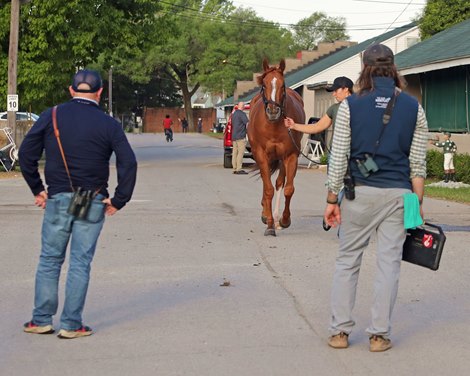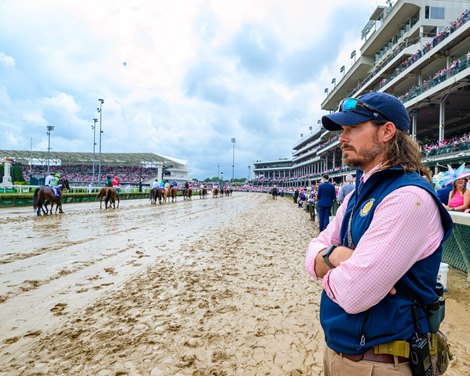A thrilling 150th renewal of the May 4 Kentucky Derby (G1) and increased betting numbers through the week were not the only positive stories to come out of Churchill Downs early this month. There was also encouraging news on the equine safety front.
Unlike last year, when Churchill Downs experienced a cluster of equine fatalities leading up to the race, there were none during the first week of racing this spring, Churchill Downs Inc. equine medical director Dr. Will Farmer said.
Farmer credited the “collaboration of many different entities—between our trainers, our attending veterinarians—all of these different groups working together to make sure that the welfare of the horse is put first.”
Farmer and others were similarly committed last year, minus the favorable outcome. Periods of safe racing or clusters of fatalities can occur, often without explanation, in a sport in which an equine death occurs during racing at an infrequent rate of approximately 1.32 per 1,000 starts.
Two horses involved in a roughly contested race May 2 at Churchill Downs that included a spill—Territoriality and Vostra —appeared to be OK “to the best of my knowledge,” Farmer said. Jockeys Irving Moncada and Emmanuel Giles required medical attention at a local hospital.
Other incidents during the week were more routine. Two horses overheated April 30, and another was pulled up that afternoon at the head of the stretch, a stewards’ report indicated.
Churchill Downs was under close watch during its most important week of racing after its 2023 spring meet was transferred last June to Ellis Park after a dozen horses died. No single identifiable cause was attributed to those deaths, which ranged from paddock incidents to sudden death episodes and musculoskeletal fractures.
A Horseracing Integrity and Safety Authority investigation into the fatalities yielded no singular explanation for the incidents, according to a HISA report released in September. But the “absence of a singular explanation underscores the urgent need for further action and analysis to mitigate risk stemming from several factors potentially contributing to equine fatalities,” the organization said in a statement at the time.
Both before a resumption of racing, Churchill put some plans in motion, “always looking to refine our processes and improve,” Farmer said.
In one addition, CDI added Dr. Dana Stead as its equine safety and integrity veterinarian.
“We definitely left no stone unturned and that’s the same for the KHRC, HISA. We all independently went to look for answers because there are still a lot of unanswered questions when it comes to the events that we saw last spring here at Churchill,” he added. “And that’s still frustrating because we want to have those answers.
“We addressed and tried to find different areas that we could improve upon, and I think we did improve upon those areas. Is that the reason for this success? I don’t think so. It may have played a part, but that’s not the reason for it.”

Churchill Downs Inc. equine medical director Dr. Will Farmer
This year, Churchill Downs track superintendent Jamie Richardson added more material to its main track and began using new harrows for maintenance—though the track surface was deemed in good condition in 2023.
“The racetrack, while it’s dirt and is inanimate, still lives and breathes through the season,” Farmer said.
The main track appeared to perform well, including on the day of the Kentucky Derby, drying out from floated, muddy conditions in the morning to a fast track for the Kentucky Derby.
Dr. Mick Peterson, director of the Racetrack Safety Program at the University of Kentucky, noted how quickly the track condition improved. He said that if the sun had stayed out another couple of hours in the afternoon, Richardson would have needed to water it.
Farmer said the procedure of requiring Kentucky Derby and Kentucky Oaks (G1) horses to be on site by entry day, a week before the Kentucky Derby, also proved beneficial, though the overwhelming majority of the competitors were on site in advance of that deadline. Just one scratch occurred in the Derby, compared to five the year before.
“That allowed additional time to see the horses on the track for the regulatory veterinarians, the Churchill veterinarians to get to know these horses, and more time for the horses to be on the racetrack as well,” Farmer said.
KHRC chief veterinarian Dr. Nick Smith and other veterinarians could readily be found observing Derby participants’ training in the lead-up to the race, as they have done in years past. They also provided pre-race examinations.

Kentucky Derby participant Society Man jogs before trainer Danny Gargan and Kentucky Horse Racing Commission chief veterinarian Dr. Nick Smith
Smith was the veterinarian who advised the scratch of morning-line favorite Forte the morning of the 2023 Kentucky Derby due to lingering effects from a foot bruise.
When contacted for confirmation of safety figures and his perspective on Kentucky Derby week, Smith did not respond with statistics or comment before the deadline for this story.
One Derby competitor, eighth-place finisher Honor Marie , whose unorthodox way of galloping with his head cocked to the side drew looks from even casual racing observers, was one of those that came under scrutiny. He underwent a bone scan before the race, and veterinarians were pleased with his physical condition, trainer Whit Beckman told Daily Racing Form.
“Having the (positron emission tomography) scanner available (here) is certainly advantageous for a horseman,” Farmer said. “It’s a very useful diagnostic tool that can really help answer questions.”
Farmer also credited other advances such as StrideSAFE sensors that have been monitoring horses in Kentucky for almost a year and equine medical record access under HISA. That access became available under the Horseracing Integrity and Welfare Unit’s enforcement of HISA’s Anti-Doping and Medication Control Program that began May 22 of last year.
“And I don’t dare leave out: our trainers and our attended veterinarians, as well,” he said. “It truly is a multifactorial thing. We use that word so frequently when we discuss injuries on the racetrack, but it’s also for the success.”










Leave feedback about this